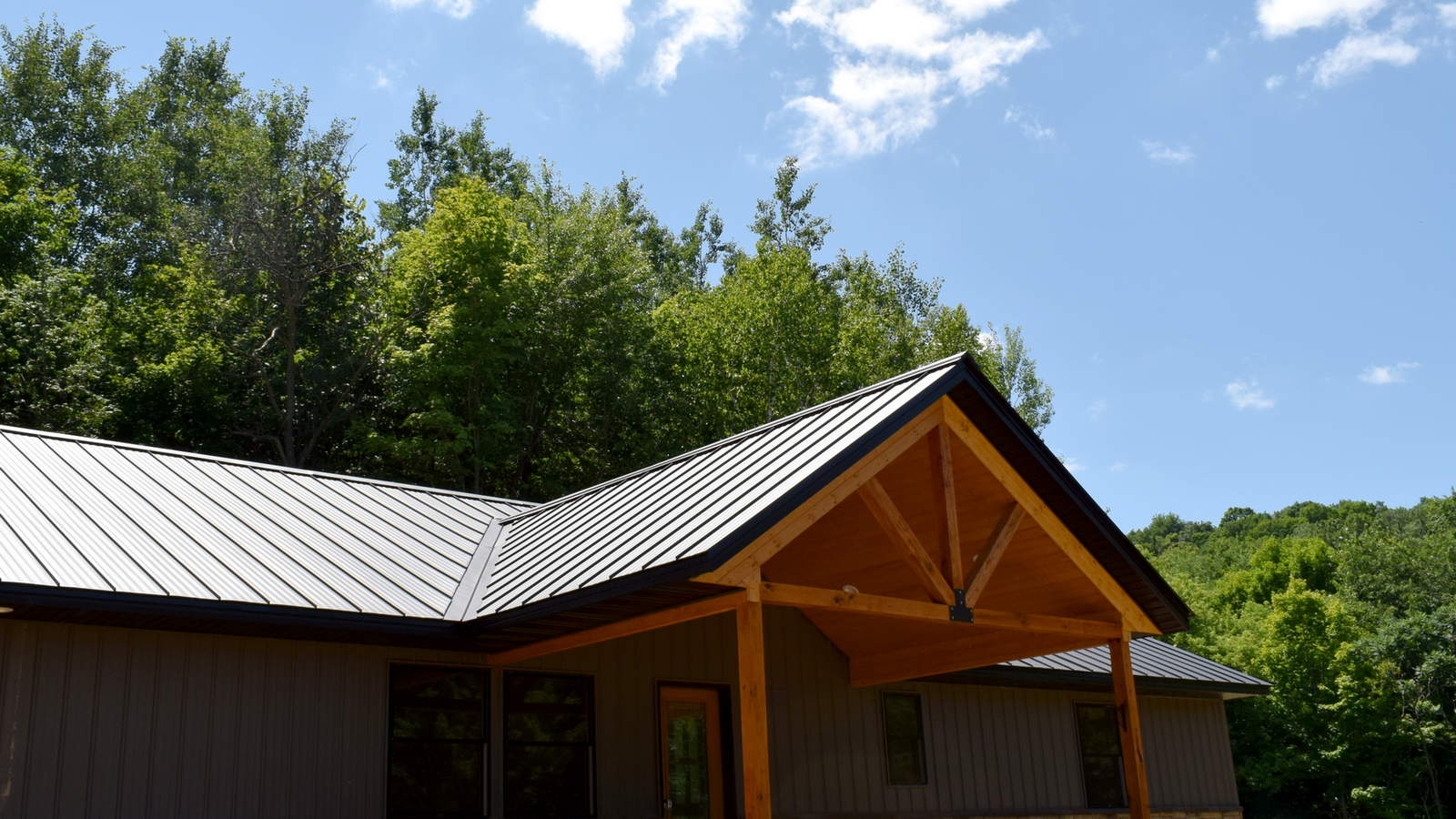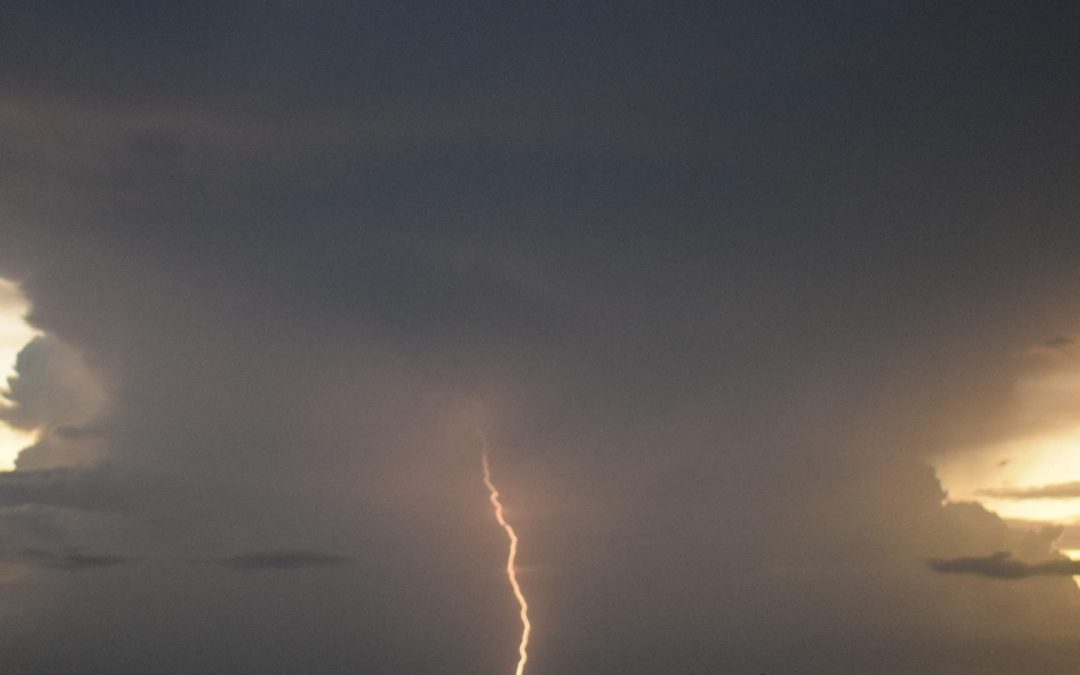You’ve likely heard that holding on to a metal pole during a thunderstorm isn’t a great idea. Yes, metal does conduct electricity. However, when it comes to attracting lightning, research has proven that metal roofing is no more likely than any other type of roofing material to attract contact with lightning.
Understanding Lightning
The Metal Construction Association describes lightning as the “flow of electrical current between earth and sky.” The brightest part of the strike (the flash) happens when electrons from the earth rush up to the sky along a path of ionization. Basically, lightning isn’t interested in your metal roof. It’s only interested in connecting negatively charged electrons with the earth’s positively charged electrons as fast as possible.
It’s impossible to predict exactly where lightning will strike, but topography is a much better indicator of the likelihood of a lightning strike rather than building materials. Lightning is more likely to strike mountain tops, hills, trees, towers, tall buildings or other tall objects. While lightning is looking for the path of least resistance, it’s drawn to whatever is closest to the sky. If you build your home on a mountain top or cliff edge, you may be more susceptible to strikes.
The size and proximity of your building compared to nearby taller structures are two more indicators. If you’re going to build yourself a skyscraper in the middle of the great plains, it doesn’t matter what building material you use. It’s an easy target. Taller and larger buildings are more likely to be struck than their surrounding smaller buildings. If you have a small house close to a huge structure, your risk is likely going to be reduced.
A cloud-to-ground lightning bolt’s main objective is to find the path of least resistance from the cloud, to the ground. Most homes are filled with many potential routes for lightning to follow in its journey. Those routes may include metal gas pipes, copper water pipes, electrical wiring, phone lines, cable TV/internet lines, gutters, downspouts, and metal window frames. Basically, anything conductive in a house is a potential route for the lightning to follow.
Lightning Protection Systems
Some structures have a lightning rod that is part of a lightning protection system. Lightning typically tries to strike the highest thing it can. That’s why trees typically get hit instead of residential homes. If a home has a lightning protection system, it is designed with poles on the rooftop to attract the lightning first, which are connected to a system that diverts the electricity around the outside of the house and offers a straight path to the ground, without entering the home’s system.
Fire Safety
When it comes to potential lightning strikes of your home, the top safety concern is fire prevention. Lightning provides intense heat. Without a protection system, and if the roof is covered with combustible materials such as petroleum-based asphalt shingles, a lightning strike can easily start a fire. Many times, insulation in the attic right under the rooftop is the first to ignite and start a fire. An attic fire is something that may not be immediately known, and by the time the fire is noticed, it’s already too late.
Because metal roofing is a non-combustible material, with the highest Class-A fire-resistance rating, metal is one of the best roofing materials for homes in lightning-prone areas.
When lightning strikes a metal roof, the voltage and risk of fire are quickly contained since metal is conductive, and provides the lightning strike with a direct path to the ground outside of the home. Even without a lightning protection system on a metal roof, the path lightning would most likely take is routed from the metal roof, through the gutters and downspouts to the ground.
Fire Ratings for Roofing Materials
Founded in 1903, Underwriters Laboratories (UL) is a not-for-profit organization that independently tests and certifies products, including roofing materials. Considered the national standard for a roof’s ability to withstand fire, the UL 790 test rates roofing material performance when exposed to fire sources originating from outside the building.
To meet UL standards, roofing materials must provide a degree of protection against flame penetration to the decking and the attic space under the roof’s surface without producing flying embers, or slipping from their installed position. Based on their performance in the UL790 test, roofing products are classified as either Class A, Class B or Class C, with a Class A rating being the highest.
Class A materials in testing have proven themselves most effective against the most severe fire testing. They provide the best protection against flame penetration as stand-alone roofing products, with excellent resistance to surface flame spread, without the need for chemical treatments or extra underlying roofing materials.
Class B materials are effective against moderate fire exposure. Some roofing materials, such as wood shingles or shake, must utilize fire-retardant chemicals to achieve a Class B rating.
Class C materials are effective against light fire exposure only, and include reconstituted wood products such as plywood and particleboard. It’s important to note that some roofing materials require additional underlying materials to achieve a “by assembly” rating of Class A fire resistance, as they only achieve a Class A rating when built as a group. For example, wood shakes typically fall in the Class C category (or unrated) if they are not treated with fire-resistant chemicals. Once treated, they can typically advance up to achieving a Class B rating.
Unrated materials are unable to meet any of the above A, B or C classifications.
What is the best roofing material for lightning?
Here’s a brief comparison of how common roofing materials perform in relation to lightning and fire.
Asphalt Shingles
Asphalt shingles are one of the most common roofing materials, mainly due to the fact that they are the cheapest. Given that asphalt shingles don’t conduct electricity, are a petroleum-based product, and are flammable, they aren’t the best choice for homeowners in lighting-prone areas.
Clay or Concrete Tiles
Concrete or clay tiles are naturally fire-resistant materials, and typically come with a Class A fire rating. It’s important to note that while clay or concrete tiles have an excellent fire resistance, there is much to be desired when it comes to performance. Simply walking on a tile roof can cause damage to the tiles, so homes in regions that may be prone to hail, hurricanes, tornadoes, or high winds may want to consider a stronger surface material.
Wood Shingles or Shake
When it comes to fire, a wood roof is one of the worst choices. Wood is obviously a combustible material, and requires substantial fire-retardant treatment to achieve a Class A or even minimally a Class B fire rating. Insurance carriers typically won’t insure homes with a wood roof in wildfire areas, even after they’ve been treated with fire-retardant, so if you live in a lighting-prone or fire-prone region, you’ll probably want to avoid a wood roof.
Metal Roofing
As mentioned earlier, metal roofing does not attract lightning and is of no greater risk of a strike than other types of roofing. In fact, a metal roof can actually make a lightning strike much less dangerous. As a non-combustible but conductive material, a metal roof provides an easier path to the ground, spreading the force out from the lightning strike and preventing concentrated hot points. Nearly all metal roofing products have a Class A rating for fire, and are resistant to nearly any type of weather condition it is exposed to.
When it is time to replace your roof, contact the team at All American Steel about getting the finest in metal panels and accessories. Our panels are available in Standing Seam or Exposed Fastener systems, and in many different colors or panel profiles. Contact the team at All American Steel today, or visit our display at the All American Do it Center home improvement stores in Tomah, Sparta, or Richland Center Wisconsin.


